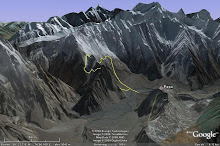Introduction
Salajit from the Northern Areas of Pakistan has been extracted, processed and distributed as a ‘wonder cure’ for time immemorial. It is also claimed that Salajit is a powerful aphrodisiac. It is collected by notorious Salajit Hunters who describes its origin as being high in the mountains necessitating long trekking hours, precarious rock climbing and dangerous rope work to reach it. Salajit is described as being exuded or ejected from rock and fissures during hot weather at altitudes of 2500-4000 mamsl and is said to occur as four varieties; gold, silver, copper and iron. Numerous chemicall analysis indicate wide ranging compositions including plant waxes, oils and acids, organic matter, minerals (including silica, nitrogen, iron, alumina, potash, and chloride) and vegetable fibres. The substance is resinous in nature, is soluble in water and burns. It has been described as a petroleum hydrocarbon and is also observed to be associated with the habitat of rare mammals ( Woolly Flying Squirrel in NWFP)
References.
http://salajitstudies.blogspot.com/
Dr George Carman







